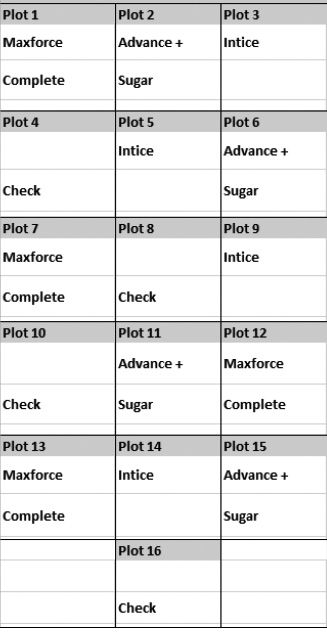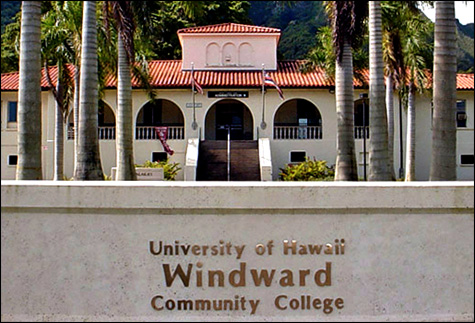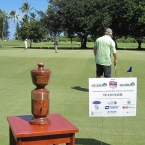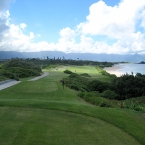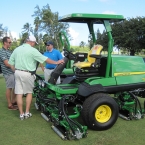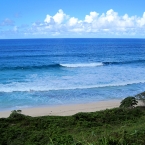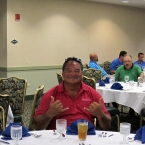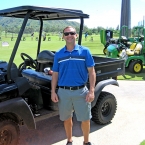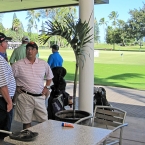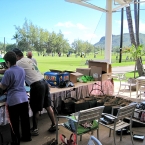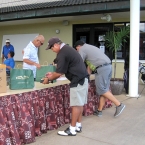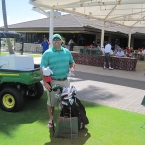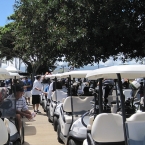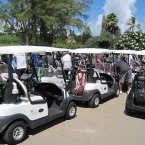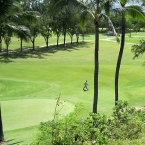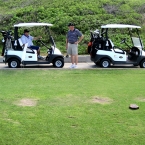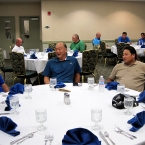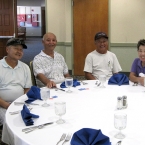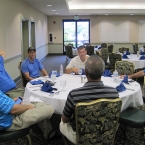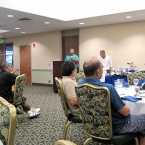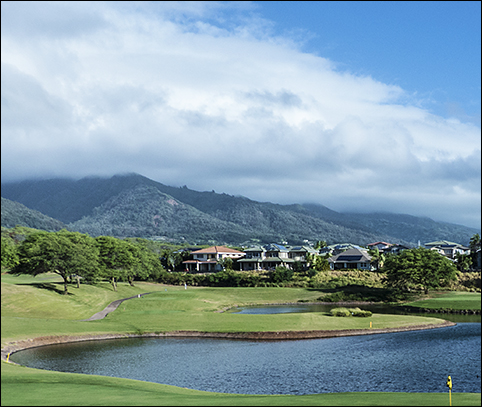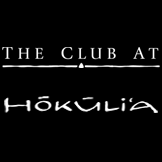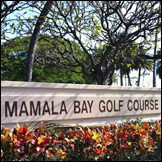Hawaii Golf Course Superintendents Blog
Ninety chapters send delegates to meeting at GCSAA headquarters
From the GCSAA Website Chapter News
Two-day session provides superintendents the opportunity for learning, feedback and community
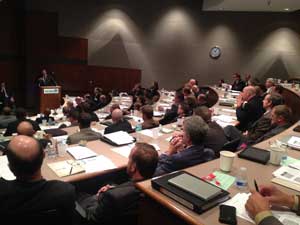 Lawrence, Kan. (Nov. 3, 2015) – More than 100 members from 90 chapters visited GCSAA headquarters last week to cover topics ranging from a final look at the revised members standards proposal, to a chance to hear from candidates nominated for the 2016 board of directors. In addition, delegates participated in constructive dialogue on association issues such as committee structure and marketing initiatives for the association’s 17,500 members.
Lawrence, Kan. (Nov. 3, 2015) – More than 100 members from 90 chapters visited GCSAA headquarters last week to cover topics ranging from a final look at the revised members standards proposal, to a chance to hear from candidates nominated for the 2016 board of directors. In addition, delegates participated in constructive dialogue on association issues such as committee structure and marketing initiatives for the association’s 17,500 members.
For some of the new attendees, it was a chance to learn more about their association.
“I now have a new appreciation for how the association is run and the true value that we receive by simply getting involved,” said GCSA of New England representative Greg Cormier, a certified golf course superintendent (CGCS) and director of golf course operations at Nashawtuc Country Club in Concord, Mass.
Jake Snyman, golf course superintendent at the Palmer Lakeside course at Barton Creek in Austin, Texas, was equally impressed: “I got more out of this than anything I have done in the last 12 years I have been a member,” said Snyman, a 40-year-old from South Africa who has been a superintendent at Barton Creek for three years and was in Lawrence representing the Central Texas GCSA.
Russ Dooge, CGCS, thought it was time well spent, too, even though he has been connected to GCSAA leadership as a chapter delegate annually since 1996.
Dooge, a longtime superintendent and now general manager with golf course management oversight at The Dunes at Maui Lani Golf Course, traveled nearly 4,000 miles from Hawaii for the opportunity to spend 48 hours talking with fellow members and GCSAA staff.
“We talked about member standards at my first chapter delegates meeting in 1997,” recalled Dooge, a member of the Hawaii GCSA. “It is important. But what we are doing in advocacy for the profession and the golf industry as a whole is huge. That is something I can’t do, and it helps me stay in business.”
GCSAA President John O’Keefe, CGCS, gave an overview of the member standards proposal that will be presented for membership approval at the 2016 Golf Industry Show in February. That proposal, developed after more than a year of discussions with chapter delegates and other members, will slightly increase the education points needed for Class A renewal as well as modify the requirements for eligibility, which will continue to be based on a combination of formal education, experience and earned education points.
“While there was some discussion about what will qualify for service points in a strong education platform, I am pleased that we have the full backing and direction from our delegates to move forward,” said O’Keefe, director of golf courses management at Preakness Hills Country Club in Wayne, N.J. “Class A member standards are important for defining who we are, both individually and collectively. They frame a member’s professional identity.”
In addition, GCSAA CEO Rhett Evans shared with delegates a brief snapshot of their association’s priority programs, an overview of how the association has been strengthened in recent years, and a preview of plans for the 2016 Golf Industry Show in San Diego. There was also time devoted to a free-flowing Town Hall session.
Please CLICK HERE to Download the “CHAPTER DELEGATES MEETING OUTCOMES” Document
Please CLICK HERE to Download the full agenda of the 2015 Chapter Delegates Meeting
Rover Ant (Brachymyrmex sp.) control at Hualalai Golf Course/Resort, Hawaii
Please CLICK HERE to Download a printable version.
Report prepared by
Zhiqiang Cheng1, Earl Sanders2, and George Nakashima3
Introduction
The rover ant, Brachymyrmex sp. (Figure 1), alate swarms have been a seasonal nuisance at some of Hawaii’s golf courses for the past several years, especially at Hualalai Golf Course / Resort on Big Island. Colonies are mainly formed in soil underneath turfgrass, bases of trees, and in leaf litter, etc. Alate swarms, attracted to objects in bright colors such as white/yellow shirts, throughout the warm summer months drive golfers off the course, as mating flights usually occur from May to August.
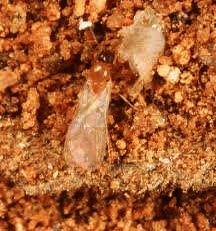
Several entomologists and ant experts have been consulted to review the situation. Major observations and findings prior to this research are briefly summarized as below:
- Brachymyrmex sp. appears to infest all turf areas throughout Hualalai Golf Course / Resort.
- Alate (attracted to light) swarms throughout the warm summer months drive golfers off the course.
- Standard treatments (neonicotinoids, chlorpyrifos, bifenthrin) have not been very effective.
- A bait manufactured on sugar and protein base may be attractive to Brachymyrmex sp.
This research aims to identify effective means to control rover ant, Brachymyrmex sp., at Hualalai Golf Course / Resort, which has been negatively affected by this nuisance turf pest. The golf course superintendent at Hualalai golf course received many complaints from golfers over the years, and is positioned to resolve this situation. In recent observations and communications with several other golf course superintendents, golfers, and home owners, it became apparent that this nuisance ant pest had affected several other golf courses in Hawaii, possibly at Ted Makalena Golf Course, and more. Therefore, this research will not only benefit the superintendent at Hualalai Golf Course / Resort, but will also bring broader benefits to other affected golf courses in Hawaii.
Objectives
The overall objective of this research is to test the efficacies of several newly developed granular ant baits against the rover ant, Brachymyrmex sp., both in the lab and in the field. Specifically,
Objective 1: To determine which ant baits to be included in the field trial, based on lab tests.
Objective 2: To determine the efficacies of selected ant baits against the rover ant, Brachymyrmex sp., in field trial at Hualalai Golf Course / Resort.
Materials and Methods
Several relatively new granular ant baits were tested in this project, including Maxforce Complete (by Bayer), Advance 375A (by BASF), Sieta (by BASF), and Intice (by Rockwell Lab), with and without sugar amendment.
Objective 1: To determine which ant baits to be included in the field trial, based on lab tests.
Seven baiting treatments were tested in the lab to determine which were to be included in the field trial. These were Maxforce Complete (MC), Advance 375A (Ad), Advance 375A + Sugar (AdS), Sieta (Si), Sieta + Sugar (SiS), Intice (In), and Intice + Sugar (InS). The ratio of bait to sugar amendment was 1:1. A control without any bait was included in the lab test. There were 4 replications for each bait and the control. Therefore, 32 petri-dishes were used in the lab test. Five active Brachymyrmex sp. individuals were placed in each petri-dish. Some soil collected together with Brachymyrmex sp. was placed in each petri-dish to mimic the field environment. Attractiveness to baits was observed, and dead ant numbers were counted right after setup, and then at 18 hours, 30 hours, and 48 hours after these ants were exposed to the baits.
Objective 2: To determine the efficacies of selected ant baits against the rover ant, Brachymyrmex sp., in field trial at Hualalai Golf Course / Resort.
Based on lab test results, selected baits were included in the field trial at Hualalai Golf Course / Resort on Big Island, Hawaii. These were MC, AdS, and In. The field plot layout, including the check/control, was as below:
Each plot was 20 ft by 20 ft, and there was a 3-ft buffer area between any 2 adjacent plots to avoid cross-treatment contaminations. Baits were applied at manufacturers’ recommended rates, and irrigation in the field trial area was ceased for 3 days after baits were applied.
Four random spots (1.5×1.5 sq ft, 1 ft deep) were dug in each plot to evaluate Brachymyrmex sp. population density on the scale of 0-3, 0 being no ant at all, 3 being extremely populated with ant eggs, pupae, workers, and alates. Three people evaluated at the same time, and the average of three people’s ratings was considered the final evaluation for each spot. Initial Brachymyrmex sp. population density was evaluated prior to treatments. The same three people did post-treatment ratings at 2 weeks after treatments. Data were subject to appropriate statistical analysis.
Results So Far
As briefly mentioned in Materials and Methods, Maxforce Complete (a.i. 1% Hydramethylnon), Advance 375A + Sugar (a.i. 0.011% Abamectin), and Intice (a.i. 5% boric acid) showed the best overall baiting effects in the lab tests. Maxforce Complete, Advance 375A + Sugar, and Intice resulted in 60-90% mortality at 48 hours. Therefore, these 3 granular baits were included in the field test.
In field trial, however, we did not observe similar results as in lab tests. Figure 2 below shows the ant infestation reduction 2 weeks post treatment. Only Intice shows minor efficacy compared to the untreated control. This result is somewhat unexpected, but not unusual as sometimes lab test results do not match well with field test results due to uncontrollable factors in real world situations.
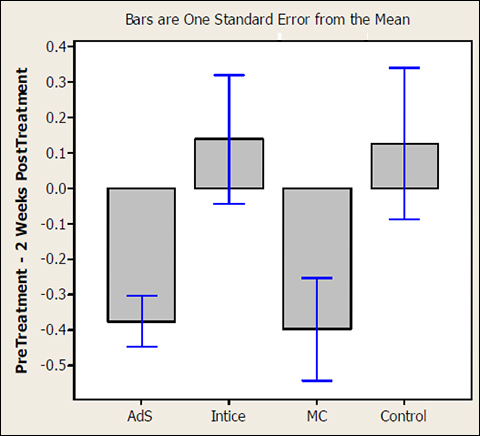
Next Steps
With additional support from GCSAA, we will continue exploring possible means to control Brachymyrmex sp. issues. Some additional granular ant baits will be tested, such as Distance (by NuFram), and modified Intice (with different a.i.), and others. A granular ant bait with fipronil as active ingredient (such as Top Choice by Bayer) will also be tested if permission from Hawaii Dept. of Agriculture is obtained. The research approach will be similar, i.e. conducting lab test first, and then field trial. Repeated applications of selected ant baits may be conducted and field efficacy tested.
In addition, we will explore the possibility of suppressing mealy bugs in the turf area and test if that will result in lower Brachymyrmex sp. population. For this approach, we will include popular insecticides for mealy bug control, such as TriStar, and others.
Acknowledgements
Funding from HGCSA, GCSAA, and Z. Cheng’s Hatch and Smith-Lever projects at CTAHR UH Manoa made this research possible. We also thank staff members at Hualalai Resort for help with field trial, and graduate student in Z. Cheng’s lab for help with lab test.
References
Arnold H. Hara, Cas Vanderwoude, Susan Cabral, and George Nakashima, 2012. Rover Ant, Brachymyrmex obscurior, at Hualalai. DRAFT COPY (05/02/2012). Unpublished data.
Personal communications with Mr. Earl Sanders (Hualalai Resort),Mr. George Nakashima (Crop Production Services), Mr. Art Guzman (Rockwell Labs), and others.
1Zhiqiang Cheng – Assistant Extension Specialist/Professor (Turfgrass and Landscape Pest Management), Dept. of Plant and Environmental Protection Sciences, University of Hawaii at Manoa, Honolulu, Hawaii
2Earl Sanders – Hualalai Golf Course / Resort, Kaupulehu-Kona, Hawaii
3George Nakashima – Crop Production Services, Hilo, Hawaii
Landscape Industry Certified Technician (LICT) 2015 Training

 If you or know someone that is interesting in becoming a Landscape Industry Certified Technician (LICT), classes for training starts in early June! Registration is limited, so please sign up early. Any questions, please contact Madeleine Shaw at 597-0708 or [email protected]
If you or know someone that is interesting in becoming a Landscape Industry Certified Technician (LICT), classes for training starts in early June! Registration is limited, so please sign up early. Any questions, please contact Madeleine Shaw at 597-0708 or [email protected]
Turfgrass education available through the University of Hawaii, Windward Community College on Oahu
A few courses which may be of interest to the professional turf industry; Windward Community College has the only educational program on Oahu dedicated to helping develop turf professionals.
We have a 3 hole par 3 facility to enhance the learning experience.
AG 182 Turfgrass Management meets Wed. 1:30-3:45pm, 1/12-5/13, 3 credits
Identification, maintenance, and planting of turf grass for home, Park, and golf course areas. Discusses irrigation, fertilization, species, and pest control.
AG 40 Turfgrass Equipment meets TH 5-7:45pm 1/13-2/11 1 credit
Teaches the operation and maintenance of equipment used in turf grass operations.
AG 36 Pesticide Safety meets T 5-7:45pm, 2/14-3/18, 1 credit
Pesticide application, formulation, toxicity, transportation, storage, disposal, and rules and regulations governing their use.
This course is worth 17 DOA recertification credits
AG 235 Irrigation Principles and Design meets W 5-7:45pm 1/12-5/13 3 credits
Fundamentals of irrigation principles, plant, soil, water relationships,
soil moisture sensing devices, delivery systems, set up of drip,
sprinkler. Use of chemigation
Registration is now open. Here is a link to the on line application:
http://www.wcc.hawaii.edu/Academics/Agriculture_Technology_CC/index.php
The cost is roughly $100 per credit.
Any questions call me at 236-9265 or email [email protected]
A quick update from the chapter Delegate Meeting in Lawrence, Kansas on October 14-15, 2014
- The Board of Directors were proposing to reduce the size of the Board from 9 to 8. The main reason being that the Past President did not want to travel as much. After hearing from the delegates, this motion was tabled.
- The Equipment Managers have an association that has roughly 300-400 members worldwide. They have approached GCSAA to join GCSAA with an Equipment Managers Classification. This was not met with open arms. Cost to GCSAA was a big reason even with it being said that the equipment companies would likely have classes for them. This motion was tabled to dead with the membership standards.
- Membership standards was the big talk. The PDI program has not worked out the way it was supposed to. To make it easy, the BOD is asking to go back to how the classifications were in 2000, which is A, B and C classes. A new Superintendent is a class B member until they have been a Superintendent for three years, then they become a Class A member. There was some opposition to this where some members felt that a pesticide license is needed. The BOD will go over this and come back next year with a recommendation to vote on in 2016.
- The last thing that was brought to the delegates was a dues increase of $10.00 for A/Superintendent members and $5.00 for C members. These dues increases are brought forward every 2-3 years and are based on the CPI. This is done so as not to have a $50.00 raise every 5 years.
There were a few other items that were presented to us and I will post those later but I did want to tell everyone about GCSAA Government Relations. Chava McKeel and her staff have done some wonderful things for GCSAA in Washington. They were helpful in getting MSMA back as well as the extended use of Nemacur. Right now they are working on meeting with the EPA regarding the Waters of the U.S. Proposed Rulemaking.
GCSAA Hawaii Chapter Delegate
Photos of the 2014 HGCSA Golf Tournament and Seminar have been Published
Extension of the Fenamiphos (Nemacur) End-Use Date has been Granted
Dear GCSAA members,
Often when I reach out to you, it is to give a status report on the association or to make you aware of a change at GCSAA. But, today I have the opportunity to share some significant news that has resulted from GCSAA’s dedication to advocating on your behalf.
 Yesterday afternoon we were contacted by the EPA to let us know that GCSAA’s request for the extension of the fenamiphos (Nemacur) end-use date has been granted until Oct. 6, 2017. We have been given a three-year extension of use of existing Nemacur stocks. Nemacur is used to control the major genera of nematodes attacking turfgrass. This includes root knot, root lesion, sting, lance and ring nematodes. The EPA plans to publish a notice in the Federal Register on the extension next week. We greatly appreciate the EPA’s understanding of the needs of our industry.
Yesterday afternoon we were contacted by the EPA to let us know that GCSAA’s request for the extension of the fenamiphos (Nemacur) end-use date has been granted until Oct. 6, 2017. We have been given a three-year extension of use of existing Nemacur stocks. Nemacur is used to control the major genera of nematodes attacking turfgrass. This includes root knot, root lesion, sting, lance and ring nematodes. The EPA plans to publish a notice in the Federal Register on the extension next week. We greatly appreciate the EPA’s understanding of the needs of our industry.
Our advocacy efforts are a team effort and are making a difference for superintendents and their facilities. A large part of GCSAA’s advocacy efforts take place behind the scenes, with meetings in Washington or in statehouses around the country or in countless phone calls to stakeholders and decision makers. But it is not just GCSAA staff or the Board or the Government Relations Committee who are championing the cause. Outcomes such as this one would be impossible without an engaged membership playing a vital role.
From the August GCM-Derrick Watts and the Prince Golf Club
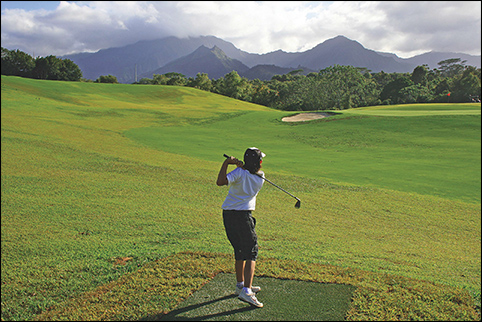
The scenery alone at Prince Golf Club on the Hawaiian island of Kauai makes for experiences usually seen in watercolor paintings or on the big screen.
There is a rain forest on the property. Jungle. Rivers. The waterfall that comes out of a lava tube behind the 13th green by itself is breathtaking. For director of agronomy Derrick Watts, being able to work at a location most others would call a vacation destination is quite the perk.
“It is unbelievably beautiful and an architectural marvel,” says Watts, a 14-year GCSAA member. “For those who play the course, it is more a journey than a round of golf.”
Prince GC, on Hanalei Bay in Princeville, may look familiar. More than 50 years ago, its beauty was amplifed in scenes shot on location for legendary duo Richard Rodgers and Oscar Hammerstein’s musical “South Pacifc.” If anything, the flm served as a launching point for the island being viewed as the place to be for romance and charm.
In his own way, Watts has helped make the golf experience a land of enchantment.
A player development program that was initiated 16 months ago at Prince by a combined effort from the management team has been a big hit. As of June, more than 600 people have tried the program, which consists of a six-hole pitch and putt. Each afternoon, the driving range is cleared to make way for the Mini Prince Par-3 that opens at 4 p.m. Holes on the family-friendly course range from 48 to 91 yards and include an 8-inch-diameter cup to try to increase playability and enjoyment. It takes about 30 minutes to play, allowing each guest a chance to play six, 12 or 18 holes.
If you have ponds on your golf course read ASAP!
If you have ponds on your golf course, please click below and read ASAP!
The National Pollutant Discharge Elimination System (NPDES) permit program controls water pollution by regulating point sources that discharge pollutants into waters of the United States.
HGCSA Presents the 2014 Annual Seminar
Hawaii Golf Course Superintendents Association Presents the 2014 Annual Seminar At the Prince Hotel Waikiki October 3, 2014
08:00 A.M. (Check in time: 7:30 a.m.)
Subjects:
- Turfgrass Nutrient Management
- Invasive Pests Of Turfgrass and Landscape Plants
- USGA Items Of Interest

Presented By: Dr.Micah Woods/Dr. Zhiqiang Cheng/Larry Gilhuly
Pre-registration required. Registration & Payment are due by September 15, 2014
Certification Points for: GCSAA CEUs and Pesticide
Please CLICK HERE to register online or to download the printable registration form.

